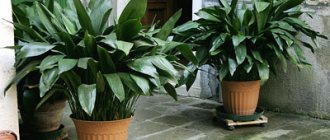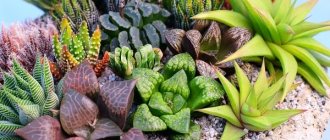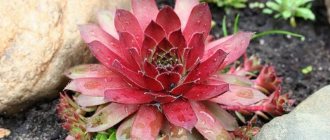The exotic and very spectacular Crossandra is just gaining popularity among flower growers around the world, but those who have discovered the charm of this flower are simply delighted with its incredible decorativeness. This culture is valued primarily for its long and bright flowering, however, it has a rather capricious character, which can be quite difficult to deal with. If you create comfortable conditions for Crossandra and pay enough attention to her, she will definitely reward you with lush and bright flowering.
Crossandra flower: a brief description
According to the botanical classification, Crossandra belongs to the Acanthus family. In nature, there are about 50 species of this plant, but only one has firmly established itself in indoor culture - Crossandra funnel-shaped. Through the efforts of breeders, a huge number of cultivated varieties and hybrids have been obtained, which today flaunt on the shelves of flower shops.
In nature, this evergreen shrub can be observed in the tropics and subtropics of Africa and Asia. In humid forests, the height of Crossandra reaches 1 m, but in indoor conditions its size is much more modest due to regular pruning and pinching. The crop has a fast growth rate and lends itself well to pruning, which makes it easy to grow a lush shrub in a short time.
Crossandra leaves have a smooth, shiny surface and clearly visible veins. Even in the absence of flowering, the dark green leaves densely covering the shoots give the bush a decorative appearance. The leaf blades are located on short petioles and are framed by a wavy edge. They reach 7-12 cm in length.
During the flowering period, large, dense, spike-shaped inflorescences appear in the leaf axils. They are strewn with many small salmon-colored flowers that reach 2.5 cm in diameter. If you provide the plant with comfortable conditions and good care, it will bloom from early spring until autumn.
Pruning crossandra shoots: how to trim a houseplant
After the end of the flowering period, the shoots are pruned, the temperature decreases slightly and a dormant period begins. Before pruning your homemade crossandra, you need to determine what appearance the plant should have, arm yourself with pruning shears and cut off long cuttings. In addition, you need to remove all dried branches, leaves and faded inflorescences.
The dormant period will last until the beginning of February, and then again you need to trim the crossandra shoots by about a third of their length and create a beautiful crown. Along with shortening long shoots, they are also pinched. This action will give the plant the opportunity to release lateral shoots, and the ornamental bush will become lush and elegant.
Watch a video about caring for crossandra, which clearly shows all the steps for replanting, pruning and forming a bush:
Types and varieties of Crossandra with photos
Despite the fact that there are more than 50 species of Crossandra in nature, only Crossandra Funnel-shaped (Wavy) has been successfully domesticated. The rest can often be observed only in greenhouses and collections of sophisticated gardeners.
Funnel-shaped
In nature, this species grows in India. In its homeland, the shrub grows up to 1 m in height, but in indoor conditions, its dimensions barely exceed 70 cm. The inflorescence of this species is very similar to a dense cob. The flowers are funnel-shaped, bright fiery shades, up to 3 cm in diameter.
Nile or Red
A low, up to 60 cm variety native to Africa. The leaves are dark green, slightly pubescent. Flowers with five petals, each of a different tone. The color range is presented in different shades: from reddish to salmon.
Prickly
An African variety, distinguished by its miniature size. The height of the Crossandra Prickly bush does not exceed 13 cm, and its dark green leaves are dotted with light veins, contrasting with the main color of the green mass. The inflorescences consist of small yellow-orange flowers, and the bracts have small, soft spines.
Tropic
A compact cultivated variety of Crossandra Funnel-shaped. The height of the bush is no more than 25 cm. There is a wide variety of colors of inflorescences, but the yellow-flowering variety is more popular.
Fortune
A hybrid variety characterized by its small size. The bush grows no more than 30 cm. The variety is distinguished by a strong root system, lush and long-lasting flowering, as well as strong immunity, which helps the plant resist various diseases and pests.
Blue
“Blue Ice” or Crossandra Blue is a rather rare and unusual species, the distinctive feature of which is loose inflorescences with bluish small flowers.
Variegated
A relatively new variety with unusually decorative leaves and bright lush inflorescences. The dark green foliage of this variety is decorated with light streaks and spots. It blooms with coral flowers collected in spreading inflorescences.
Green ice
Crossandra Green Ice is a very rare variety with unusual flowers of a beautiful turquoise color. Outwardly it is very similar to the Blue Ice variety, but differs in the brighter color of the buds.
3.Varieties:
3.1. Funnel-shaped or wavy-leaved crossandra - Crossandra infundibuliformis
A green tropical shrub, native to South India and Sri Lanka, reaches a height of 30 - 90 cm, has abundantly branched, erect stems. The leaves are dark green, glossy, lanceolate, reaching a length of 5 - 10 cm. The flowers are collected in small apical inflorescences and have asymmetrical petals of yellow, orange, salmon, coral, and red. flowering can occur at any time of the year.
↑ Up,
3.2.Crossandra funnel-shaped Fortuna - Crossandra infundibuliformis 'Fortuna'
Perennial evergreens with very abundant and long-lasting flowering. It has glossy, green, lanceolate leaves with branched veins slightly recessed into the leaf blades. It develops very quickly. During the flowering period, short peduncles are released at the tops of the stems, which bear bright, orange flowers.
↑ Up,
3.3. Crossandra pungens
Evergreen plants that can safely be classified as both decorative deciduous and flowering. This type of crossandra is often grown as a ground cover plant. The bushes have erect stems with long, lanceolate, dark green leaves. On the surface of the leaf plates, leaf veins are highlighted with a silvery tint. Leaves collected in whorls. During the flowering period, large inflorescences with delicate, cream or yellow flowers appear at the tops of the stems.
↑ Up,
Caring for Crossandra at home
To grow the oriental beauty Crossandra, you will have to take care of high humidity, sufficient light and heat, and also remember to pay attention to the plant. Favorable, close to natural conditions, timely feeding and pruning will help to increase and preserve the beauty of this exotic plant for a long time.
Bloom
In its homeland, Crossandra blooms all year round, but at home, especially in temperate zones and northern regions, the flower simply does not have enough sun. Therefore, in indoor Crossandra, flowering begins only in April-May and continues until September. In addition, the main condition for abundant flowering is a full rest period during the cold season.
After properly organized wintering, in the spring the plant scatters with large inflorescences strewn with many bright tubular asymmetrical flowers. The flowers themselves are odorless and remain fresh for several days. However, there is some trick that helps prolong the already long flowering - when the tip of the inflorescence begins to fade, it is cut off, after which Crossandra releases a new flower arrow.
After the buds fade, seed pods appear in their place, which, when ripe, can scatter seeds over several meters.
Lighting
The tropical beauty loves to bask in the rays of the southern sun, but it is better to protect it from direct rays with an openwork curtain or create another barrier so that the light dissipates a little. At home, the flower pot is placed on the south side, and in the summer it can be moved to a glazed balcony or loggia. You should not take Crossandra into the garden, as the plant reacts poorly to wind and precipitation.
In winter, the flower also needs good lighting, and responds to a lack of light by elongating shoots and even a lack of flowering. In the cold season, even when Crossandra is at rest, it should receive a lot of light, but if this is not possible, then it is advisable to take care of additional lighting and install phyto-lamps or fluorescent lamps that will replace the dim winter sun.
Temperature and humidity
In the room, Crossandra feels good at a temperature of 18-28 degrees. At the same time, the flower does not tolerate fluctuations in indicators and drafts. It is undesirable for the thermometer to rise above +300C in summer and drop below +150C in winter. Some varieties are less demanding in terms of maintaining temperature conditions and can tolerate short-term cold spells, but it’s still not worth the risk - Crossandra is very tender, thermophilic and may not forgive such a serious omission.
In the room where Crossandra lives, it is advisable to maintain a high percentage of air saturation with moisture. In the warm season, especially when it is hot outside, the humidity in the room should be at least 70%, and in the cold season - about 50-60%. To create such conditions you will have to work hard. It is advisable to install a household humidifier in the room, place vessels with water nearby, and place the pot on a tray with wet pebbles, expanded clay or moss. You should also spray the crown of the plant more often with warm, soft water from a spray bottle; this should be done especially often in extreme heat, but avoid getting it on flowers and buds.
In addition, Crossandra loves fresh air, but is afraid of drafts, so during ventilation the flower is taken to another room.
Watering
When regulating the watering regime, it is important to find the “golden mean”. Crossandra is extremely critical of excess moisture and overdrying of the earthen clod.
Watering is carried out with soft, settled water at room temperature as the top layer of soil in the pot dries. If you do not water the flower in time, its leaves will begin to wither, lose turgor, and then urgent resuscitation will be required. The plant will not survive if it is left in a dry substrate for at least a day, so at the first sign of a lack of moisture, the flower pot is placed in a container with water for a couple of hours until the leaves straighten out again.
It is important to regulate the amount of moisture depending on the temperature in the room. In hot weather in summer, watering should be plentiful, and in winter more modest. During hibernation, the flower is watered moderately, once every 2 weeks.
Fertilizer
During the period of active growth and flowering, Crossandra is fed with mineral compounds for flowering crops. You can alternate mineral and organic preparations. They are applied 3-4 times a month from spring to autumn.
Newly transplanted Crossanders are not fed for the first 2 months.
Shaping and trimming
In the fall, after the end of flowering, the Crossandra is radically pruned. At this time, remove all dry, damaged, thickening or spoiling the appearance of the bush branches. They can be cut to the desired length, but no more than 1/3. Crossandra tolerates even severe pruning well, and when comfortable conditions are created, as well as good care, it quickly restores lost volume thanks to its rapid growth rate.
In the spring, they carry out a sanitary haircut and shorten excessively elongated branches. It is important to carry out the procedure before the buds swell, otherwise flowering can be delayed or even canceled.
As it grows, the stems of this fast-growing shrub can become bare and elongated, so it is important to periodically pinch out the tops of the shoots. To enhance branching, bushes begin to be pinched at a young age. Also, during flowering, faded inflorescences should be trimmed periodically.
Rest period
Wild Crossandra does not have a pronounced dormant period. The plant grows and blooms all year round, but the short daylight hours of temperate latitudes have made adjustments to the habits of this crop. In order for the plant to gain strength and scatter many flowers with the arrival of warm sunny days next year, it is important to provide it with a comfortable winter.
In autumn, when the flower stops blooming and slows down, it is necessary to reduce watering to a minimum, stop adding nutrients and move the plant to a cool room. The optimal temperature during this period is +16-+18 degrees and humidity is around 50-60%. During cool wintering, stop all spraying, and instead periodically wipe the leaves of Crossandra from dust with a damp cloth. But lowering the temperature and reducing watering should not affect the quality of lighting in any way - it should still remain bright, so it is advisable to install phyto-lamps or organize LED lighting.
In February-March, when the plant begins to gradually return to its normal state, pruning is carried out. All weak, damaged, broken or elongated branches should be removed to give the bush not only a neat, healthy appearance, but also the desired height. Healthy shoots are pinched at a height of 5 cm from a pair of leaves and then the bush will begin to branch more actively, become more magnificent, and there will be many more inflorescences.
Bloom
Crossandra blooms with spikelets of bright flowers. The most common color is orange.
Depending on the variety, they can be orange, yellow, pink, blue and green. With sufficient care, crossandra blooms from spring to autumn. Flowering is also possible in winter, but this greatly depletes the plant. Therefore, in winter the flower should be dormant.
It is recommended to remove bloomed buds in a timely manner. To do this, the flower stem above the top pair of leaves is cut. Thanks to this operation, new buds will appear on the bush.
Crossandra transplant
Crossandra is replanted as it grows. Typically, young specimens require annual replacement of the pot, and older ones – once every 2-3 years. Transplantation is carried out in spring or autumn, but if the plant was recently acquired, it is kept in quarantine for some time and then immediately replanted. However, if the bush is in bloom, then replanting is carried out after the last buds have faded.
Transfer rules
If the Crossandra bush has recently become part of your home collection, then you need to replant it immediately or first wait for the buds to wither, and only then replant. The procedure is carried out in the following sequence:
- A layer of expanded clay, clay shards, broken bricks or small stones is placed on the bottom of the pot.
- Pour in a little nutrient substrate.
- Take the flower out of the container, shake it off the ground and remove all diseased roots.
- The rhizome is placed vertically in the planting container.
- Sprinkle with earth and fill all voids.
- Water and, if necessary, add a little soil.
Adult specimens are replanted as needed. In general, the flower does not tolerate change well, so they often try not to disturb it. Crossandra is replanted by transshipment, so as not to damage the integrity of the earthen coma and root system.
The soil
For planting, you can use a ready-made flower substrate. A great potting mix for azaleas. You can also independently prepare a soil mixture from leaf, compost soil, peat bog and sand in a ratio of 3/3/3/1 or equal parts of humus soil, peat bog and sand. It is important that the soil is loose and allows water and air to pass through well. Self-prepared soil mixtures should be pre-calcined in the oven or steamed.
Choosing a pot
The new pot should be slightly larger than the previous one. The material of the planting container can be any, the main condition is the presence of drainage holes. It is advisable to choose dishes according to the size of the root system, 2-3 cm larger.
Actions after purchasing Crossandra
If you bought a flowering crossandra, then wait until all the inflorescences wither before replanting. Then the soil is completely changed. Only that lump of earth that adheres tightly to the root system is left. To stimulate flowering, the plant is often treated with harmful drugs, which is why the soil is replaced.
Crossandra, purchased after the flowering period, is moved to new land after 1-2 weeks. This waiting period is necessary for the plant to get used to the conditions, because transportation and transplantation are stressful.
Crossandra propagation methods
At home, you can get a new Crossandra bush in two ways: by cuttings or by sowing seeds.
Cuttings
Cuttings are the easiest and fastest way to obtain a flowering plant. The 8-10 cm long parts of branches remaining after pruning are perfect for rooting. The leaves are removed from the bottom of the cuttings, treated with preparations for root formation, and after that they can be planted in a damp peat-sand mixture. Rooting occurs in a humid mini-greenhouse with bottom heating at a temperature of about 25 degrees. The container with the seedling is placed in a bright place, the humidity of the substrate is constantly monitored and the greenhouse is periodically ventilated. If everything is done correctly, then after 3 weeks roots will begin to appear, and when the seedlings begin to grow and new leaves begin to appear, they can be transplanted several at a time into new small pots filled with nutrient substrate. After transplantation, the first pinching is carried out.
In a similar way, you can root Crossandra branches in peat tablets. The tablets must first be prepared. They are pre-soaked, squeezed out, a small depression is made, then cuttings treated with a growth stimulant are planted and a greenhouse is made from a transparent cup or glass jar. In this case, it is worth paying more attention to humidity, since peat tablets dry out very quickly. After the seedlings take root, they are transplanted into pots, pinched and cared for as adult plants.
Crossandra cuttings can be rooted first in water. To do this, a tablet of activated carbon is first dissolved in a glass. When the branches grow roots up to 1 cm long, they can be transplanted into a pot with substrate.
Seeds
It is best to purchase seeds for planting at a flower shop or order online. Domestic Crossandras growing in pots are most often hybrids, so if you collect seeds from them, the new plants will most likely be completely different from their “parents.”
Before planting, the seeds are soaked for 2 hours in warm water at a temperature of 24-26 degrees with the addition of a growth stimulant (for example, zircon). Then the planting material is sown in a sand-peat soil mixture mixed with moss and coconut fiber. They are sealed to a depth of 5 mm and covered with film. The dishes with seedlings are placed in a warm, bright place. The optimal temperature for emergence of seedlings is not lower than 22-30 degrees. It is important to maintain high humidity, periodically ventilate the greenhouse and moisten the soil surface with a sprayer. After 2-3 weeks, the first shoots will begin to appear, and after another month the seedlings can be transplanted into small pots. At the beginning of autumn, the plant is replanted and the first pinching is carried out.
Care errors and their elimination
What mistakes do flower growers make when caring for crossandra, what they mean and how to eliminate them:
| Problem | Cause | Elimination |
| The leaves are turning red | Direct sunlight hits the leaves | Move the plant away from the window or shade it |
| The leaves become white and brighten | Burn Metabolic disorders (chlorosis) | Shade a flower Watering and spraying with ferrovit, antichlorosin until new healthy leaves appear. Replanting into new soil is advisable. |
| The leaves turned black and fell off | Cold Root rot | Place the plant in a warmer place. Avoid drafts Treatment for root rot: cut off the affected roots, leaves, shoots, replant in a new pot and fresh soil, water with a fungicide, place in a warm, well-lit place. Do not water until new growth appears. |
| The leaves dry out and curl; leaves drooped | Dry soil, low humidity | Increase watering and humidification |
| Brown spots appeared on the leaves | Roots are frozen, soil is too wet | Place the pot on a stand to keep the roots warmer. Reduce watering |
| Scanty or no flowering | Insufficient lighting Plant age Too much pruning | Highlight the plant Follow the rules when pruning a flower |
Pests and diseases
If sprayed frequently or if moisture remains on the leaves for a long time, Crossandra may suffer from leaf mold. In this case, you need to remove all damaged leaves and treat with fungicidal preparations. It is best to provide the plant with high humidity indoors, and spray only in hot weather.
If the air in the room is too dry, the plant may be affected by aphids and spider mites. If pests are detected, treat with soap solution, garlic water or insecticides.
Crossandra: what pests threaten the plant
In this chapter, we will analyze the problems associated with attacks by harmful insects and suggest options for getting rid of them.
- Drying, curling and falling of leaves. Here and there yellowish spots and dots appeared, with white cobwebs. It is related to spider mites . A systemic insecticide (Fitoferm, Actellik, Derris), or more precisely, spraying, will help here. As a preventative measure, inspect the plant to detect the first signs of pest attack. It is also necessary to keep the leaves clean: spraying or wiping with wet wipes. Humidifying the air and ventilating the room will also help. Spider mites love dry and stuffy rooms.
- Curling of young shoots, leaves and peduncles. Typically, if you look closely, you can see tiny insects. This is an aphid. The fight against it should begin by removing seriously affected areas. Then wash the bush with a warm shower, and after drying, treat it with any aphid preparation containing permethrin.
- The growth of the plant is severely inhibited against the background of limp and dull leaves, whitish small lumps and a sticky coating. This is an attack by a mealybug , sucking out all the juice from the plants. The first thing to do is isolate the plant. This will help protect companion plants, since the scale insect quickly infects neighboring plants. Next, remove the pest using a damp cloth or rinse under running water. Spraying or washing with a soap-alcohol solution will also help (hot water - 1 liter, laundry soap - 20 g, alcohol - 20 ml). In case of mass damage, treatment with insecticides (Fufanon, Aktar, Aktellik) cannot be avoided.
- The underside of the leaves is full of greenish larvae, the bush is full of flying small insects. This is a whitefly attack. Start by removing the affected leaves. Next, you should wash the bush under running warm water, thus removing most of the harmful insects. Then it is necessary to treat the above-ground part of the plant and soil using the Aktar solution (see instructions). It may take several treatments to finally get rid of this prolific pest. You can also spray the crossandra with Confidor against whiteflies, covering it with polyethylene overnight. True, this drug smells strongly, so it would be a good idea to take care of it outside the home (utility room).
Problems during cultivation
Crossandra can react to errors in care and not entirely favorable conditions with the following symptoms:
- The tips of the leaves dry out, curl and fall off - dry air in the room. You should install humidifiers, water containers, or increase the humidity in some other way.
- The plant sheds its leaves - low temperature in the room, drafts. You need to move the plant away from open windows or move the flower to a warm, well-lit room.
- The leaves turn yellow, crumble, brown spots appear on the plates or petioles themselves - excessive watering. It is necessary to set the correct watering regime and moisten the soil after the top layer of soil has dried, and also drain the water that has flowed into the pan.
- Leaves lose their color and turn yellow - lack of nutrition. Perhaps the soil in the pot is depleted or needs fertilizing.
The Crossandra plant has won the hearts of flower growers around the world with its brightness and charm. She loves good company and is perfect for decorating a tropical green corner. Its bright flowers will look great among ferns, arrowroot, begonias and other tropical plants, which will not only emphasize the beauty of its flowering, but will also create a favorable microclimate and saturate the air with moisture. At home, such a flower will definitely attract admiring glances and, with good care, will become a real pearl of the home collection.
Features of seasonal care
It is important to remember that at different times of the year the crossandra needs special care:
- In spring and summer , the plant needs intense lighting; it is important to avoid direct sun. Humidity should be high - at least 70%. Therefore, it is necessary to spray the flower regularly. Maintain a moderate temperature - about 20°C. Crossandra will like fresh air, but without drafts and sudden temperature changes.
- In winter and autumn, the plant can be placed on the south side. Direct rays are acceptable. In the morning and evening you need to highlight the plant. The air must be humidified, but at low temperatures the humidity should be no more than 50-60%. In autumn, the recommended air temperature is 20-25°C. In winter – low (16-18°C). Do not allow the temperature to drop too much. At temperatures below 12°C, crossandra dies.











